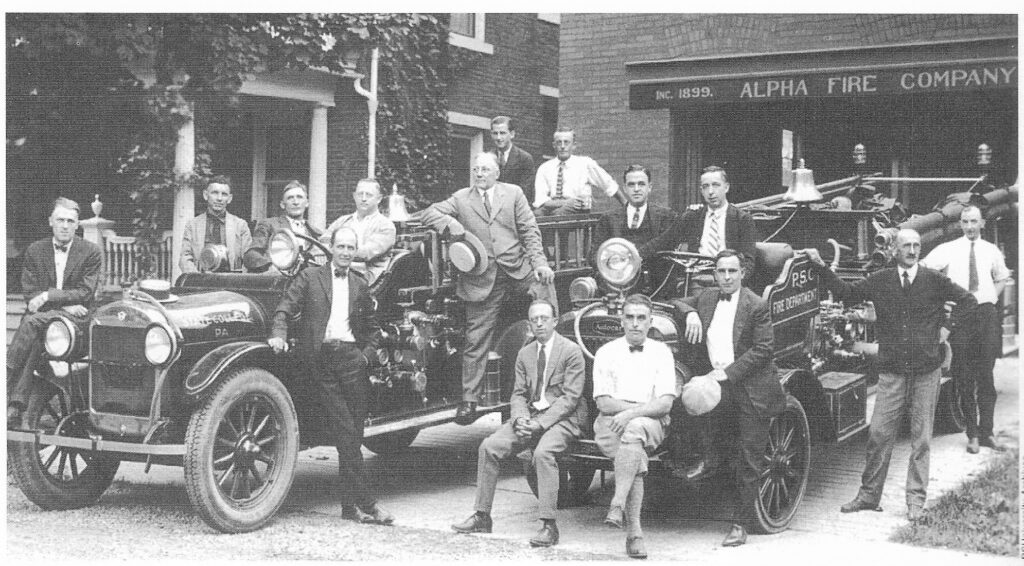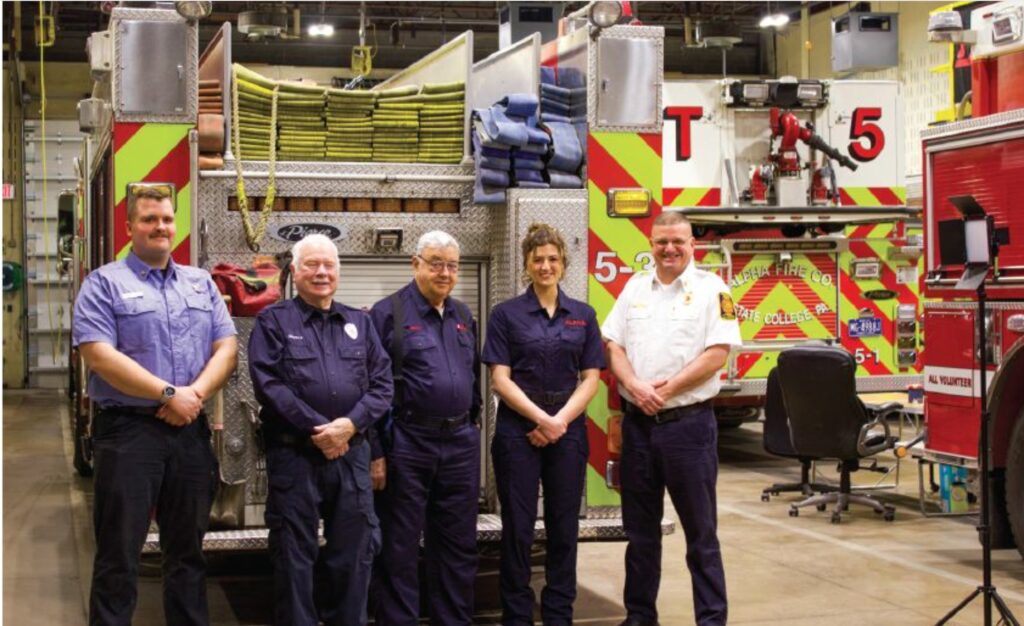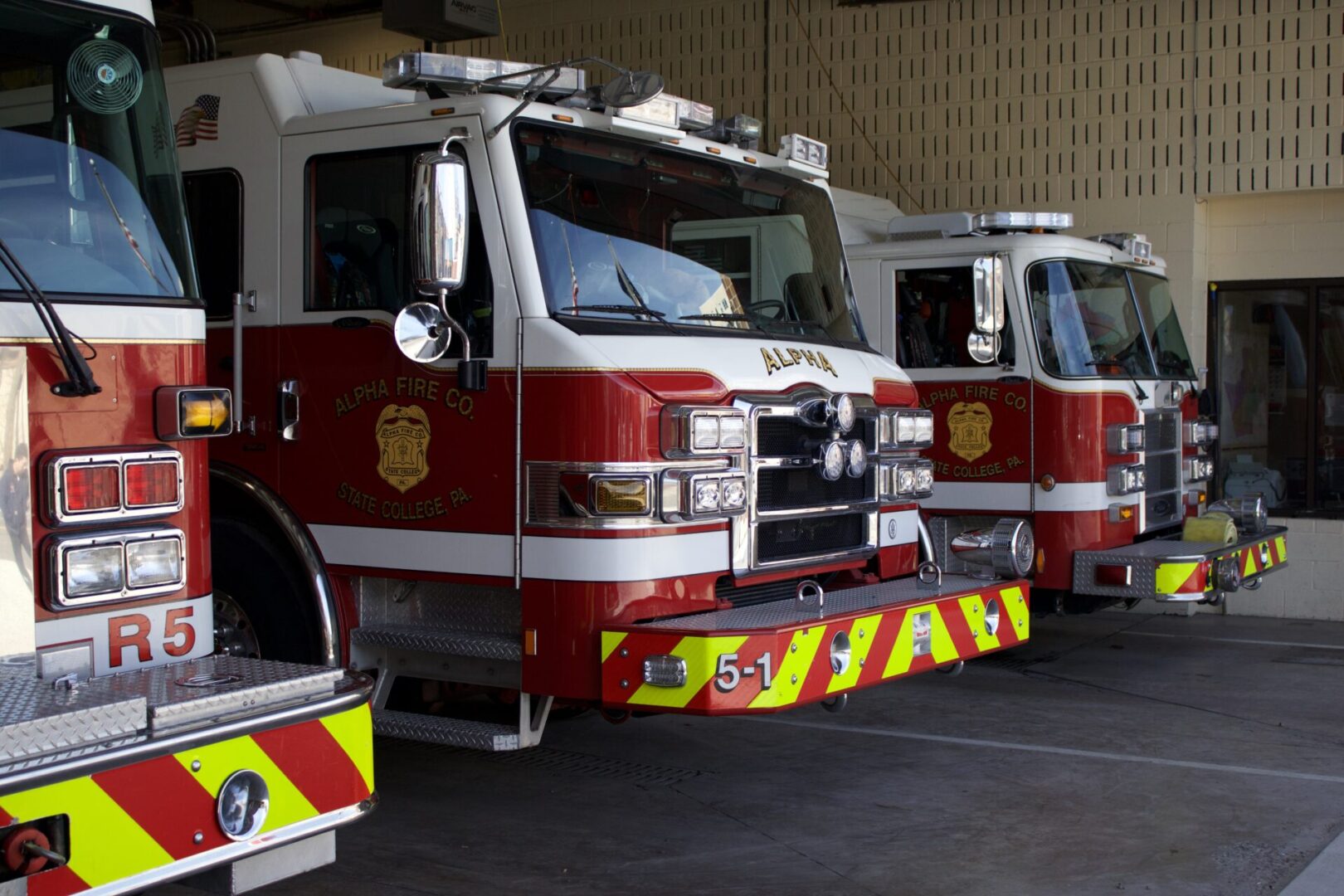In 1899, a group of volunteers founded the Union Fire Company to serve the Borough of State College. The organization, renamed Alpha Fire Company a year later, used hand-drawn hose carts to fight fires in the few blocks of homes and buildings surrounding the campus of the Pennsylvania State College, which had its own student-run volunteer fire company.
The community and the organization have both grown and changed immensely since then, but, as Alpha Fire Company prepares to celebrate its 125th anniversary this year, one thing has remained constant: the State College community has been fortunate to have been served by a group of dedicated and well-prepared volunteers for the past century and a quarter.

Evolving with the town
Carmine Prestia is the second of three generations of firefighters in his family. His father was a volunteer firefighter in Union County, and his sons are both firefighters now—Andrew is a volunteer with Alpha, and Chris is a career firefighter in Maryland.
The retired district judge was working as a police officer when he joined the company in 1972. He has remained an extremely active volunteer, serving as a driver these days, even as he continues to work as a judge in Tyrone two days a week.
Not only has Prestia seen many changes in his 52 years with the department, but he has been instrumental in initiating and implementing many of those changes.
As a “young Turk,” Prestia says, he pushed for safer and more sophisticated gear than the rubber coats and boots the firefighters used when he joined.
In 1987, he advocated for dropping the volunteer age requirement from 21 to 18, making it easier to recruit Penn State students.
“It was a fight to make that change, but it had to come, and it helped, because we’ve taken a lot of people under the age of 21, and they’re contributing valuable work.” Prestia says. “To be honest, if we hadn’t done it, I don’t think we would have survived as a volunteer company.”

In 1997, Prestia also chaired the committee in charge of renovating the station, which had moved from its original home on Fraser Street to the corner of Beaver Avenue and North Atherton Street in 1974. The station added bunk rooms, a weight room and a kitchen, creating a space for volunteers to live rent-free—another effective recruiting tool to attract and retain Penn State students and young adults.
In 2007, Prestia encouraged the Centre Region Council of Governments to create a paid fire director position to alleviate the volunteers being overburdened with administrative work, allowing them to focus all of their energy on training and responding to incidents.
Shawn Kauffman is COG’s current fire director. Like Prestia, Kauffman followed in his father’s footsteps to become a second-generation volunteer firefighter. In 1988, he became a member of Alpha’s first class of volunteers admitted under the lower age requirements. He was nineteen and had some prior experience, having joined Boalsburg Fire Company’s junior program at 17. He also had spent much of his childhood at the Alpha Fire Station with his father.
“As soon as they changed the age, I was in line ready to sign up,” Kauffman says.
He went on to hold many leadership roles within the company, including fire chief and assistant fire chief, eventually turning his passion for emergency response into his career.
A complex organization
Today, in addition to Kauffman, five paid positions support the fire company, including assistant chief and captain, as well as some part-time positions. Kauffman’s goal as fire director is to keep Alpha Fire Company a volunteer organization for as long as possible, and he does not expect the organization to fully become a paid fire company during his lifetime.
“Our goal is to support and supplement the volunteer fire company. As we see gaps forming in service, then we try to fill those,” he says. “What we will most likely do is be a mostly volunteer combination department for many years.”
The current model appears to be working well. At its present level of 100 volunteers, the organization effectively handles the primary four municipalities it covers: State College Borough, College Township, Ferguson Township and Patton Township. It also provides automatic aid to Halfmoon and Harris townships. Response times compare favorably with the national standards set by the National Fire Protection Association, Prestia says.
Overall, the organization is a complex one, with three major sources of funding. COG provides funding for the company’s main operational expenses, including the purchase of apparatus, which includes all vehicles customized for firefighting usage. Penn State University contributes about ten percent of Alpha’s operational budget, as well.
The Firefighter’s Relief Association is a highly regulated source of state funding for things related to firefighters’ health and safety, including training and equipment like breathing apparatus and turnout gear.
The FRA also pays for biannual physicals and eye exams for firefighters, and provides insurance policies to cover officers for the possibility of being killed in the line of duty, which has only happened three times in the history of the company: Philip Foster died in 1930 of a heart attack following a fire; Larry Oberle died in an ambulance accident in 1971; and Charles Zeigler died in 1981 in a car accident while en route to respond to a fire. Plaques honoring these fallen firefighters hang on a wall in the borough station.
The final source of funding comes from donations to the fire company, which pay for “creature comforts” that make the station a comfortable and enjoyable place for firefighters on duty to spend time, including furniture, kitchen appliances and even video game consoles.
The organization is also complex in the wide variety of specialized roles volunteers can fill.
There are three service groups within Alpha Fire Company: engines, trucks and rescue. Engines provide the water supply and focus on extinguishing fires. Trucks focus on things like finding the source of the fire, determining building layouts, controlling utilities and ventilating structures. Rescue centers around the “toolbox on wheels,” a truck filled with all kinds of stabilization and extrication equipment.
The fire police unit is also a part of the company. This unit focuses on providing crowd and traffic control at fire and accident scenes.
“They are not necessarily going into burning buildings, but sometimes taking care of traffic around a fire or an accident is as important as fighting fires,” Prestia says.
Within all of these units, there are many layers of leadership roles, and extensive training is required at every level. Volunteers must complete at least 30 hours of training each year, and new recruits can expect to spend most of their free time training. This includes an in-house Pre-Emergency Response Training program in addition to the training and testing required for national firefighter certification.
As one of the first steps in PERT, new volunteers are trained to hook up a fire hydrant. Once they master this basic skill, they are able to contribute something useful at a fire scene and thus can begin answering response calls as early as a month after joining.
Being part of the action is crucial to the recruitment and retention of volunteers—something that was demonstrated when the community inactivity of COVID-19 caused a significant drop in incidents and a corresponding drop in active volunteers.
“They’re trained to respond, and they like to respond. If you’re not going on calls, you’re not likely to have people hanging out,” Kauffman says.
The number of volunteers is once again on the upswing as incident calls increase. Unfortunately, many of these calls—more than half of the 1,425 incidents Alpha Fire Company responded to in 2023—are what Kauffman calls “false alarms” or “good intent calls,” when Alpha shows up to a scene that turns out not to need their services. Firefighters are also frequently called to downtown apartment buildings to perform elevator rescues.
“We’d like to reduce that number, but with the construction of these new high-rise buildings and all the different alarm systems that are in our community, that’s not going down any time soon,” Kauffman says.
The relatively recent spurt of new construction in downtown State College is not the only growth that has affected Alpha Fire Company. As new housing developments have popped up across the region, the service area has expanded, and new satellite stations were added in 2001 and 2003—one in the lower level of the College Township building on College Avenue, and one on Green Tech Drive in Patton Township. Long-range plans include the possibility of adding a station in Ferguson Township.
In addition, Prestia says, “We are bursting at the seams in our current [downtown] building. That is going to have to be addressed at some point.”
Celebrations and Camaraderie
Prestia says, “One thing I am proud of is, we have become extremely diverse in our membership,” citing the diversity in ages, nationalities and educational and professional backgrounds, and the increasing number of female members.
Women make up about ten percent of Alpha volunteers. The company has its first female lieutenant, and last September, an all-female attack line responded to a house fire for the first time in company history—a big deal worth celebrating once, Kauffman says, but he expects this to become commonplace in the future.
Even as the company evolves with the times, they are proud of their past. The meeting room in the downtown station is filled with memorabilia, including display cases of patches from other fire companies, old uniforms, antique fire extinguishers, old box alarm maps, scrapbooks (currently being digitized for posterity), photos from fire scenes and of past fire chiefs, and the old steam whistle that used to summon firefighters from atop the Penn State power plant on Burrowes Street.
Alpha plans to celebrate its 125th anniversary on July 20 with a community event on South Allen Street. Current and retired apparatus will be on display, ladder bucket rides will be offered and there will be a bounce house and other activities for kids.
It will be reminiscent of a nostalgic piece of the company’s past—the Alpha Fire Company Fourth of July Carnival, which was held on Allen Street from 1927 until the mid-1960s, when it moved to Westerly Parkway for about another decade.
The organization continues to interact with the community at large through open houses, as well as through what has become their most visible public service event and a beloved local tradition since it began in the 1990s: the Christmas Eve Santa Run.
The Santa Run takes two convoys of vehicles—and two Santas—to visit many neighborhoods in the Alpha Fire Company service area on Christmas Eve. The volunteers spend all day decorating the apparatus with lights before they hit the road for about five hours, starting at 4:30 p.m. With lights flashing and horns honking to announce his arrival, Santa waves at his fans from a ladder bucket while volunteers hand out candy canes and dog biscuits.
Upon the Santas’ return to the station, Prestia and his wife serve the volunteers with a special Christmas Eve meal they have prepared in the company kitchen.
“It’s all part of the camaraderie thing,” he says.
That “camaraderie thing”—the strong bonds formed among firefighters—is what seems to draw many to make this noble calling such a big part of their lives.
“It’s a lifestyle. People come in here and dedicate so many hours, spend so much time engaged in the service, it becomes a fraternity,” Kauffman says. “It’s like a very large family.”
“This is going to sound corny,” Prestia adds, “but it’s really about being a part of something bigger than yourself.”

Grace Mau: ‘Holy cow, this is real!’
Currently a junior at Penn State, Grace Mau joined Alpha Fire Company in January 2023.
“I moved in across the street to an apartment in The Graduate my sophomore year, and I would hear the engines going, and I just felt like I had to get involved,” she says.
Growing up, she saw her mother serve in the Army Reserves, so she always knew holding a service position like this as a woman was a possibility. She got a taste of the volunteer fire company life at her hometown fire company in Franklin Township the summer after her freshman year.
She has completed Alpha’s Engine PERT program, which covers basics like hydrants and hose lines, fire alarms and elevator rescues, and now she is working on her Fire 1 certification.
Mau recalls being taken aback a bit by the heat when she handled water runs at her first fire.
“I remember stepping out of the engine and feeling how hot it was, and I was just like, ‘Holy cow, this is real!’” she says.
Mau currently is a live-in at the downtown station, which makes it easy to run calls more often. A mechanical engineering major, she says it takes some discipline to focus on schoolwork rather than responding to every call that comes in to the station.
Mau says her favorite thing about being an Alpha volunteer is the people.
“I remember coming to college and being worried about finding a community here and missing my family, but the people here sort of fill that void. They’re like my family,” she says.
After she graduates next year, Mau says, “I definitely think volunteer firefighting will be in my future. But I think it’s going to be hard going from a volunteer station like Alpha, which is run so well and the training is immaculate, to who-knows-what at another volunteer station. Because from what I can tell, Alpha is pretty darn unique.”
Bill Markle: ‘It’s like a second family’
Bill Markle has been an Alpha volunteer for 59 years.
He joined in February 1965, and since then, he says, “I’ve seen a lot of changes. Back at that time, our main attack engine was a 1949 Mack pumper. … The only turnout equipment we had was a rubber coat and hip boots like a fisherman used to use. All was carried in the vehicle under the seats. When we got to the scene, we were lucky if we didn’t end up with two left boots.”
Markle still remembers the first major incident he responded to: a large explosion at the Nease Chemical Company plant on Struble Road, near what is now the Nittany Mall, in November 1965.
“It was a Saturday evening, and I could hear it all the way out in Centre Hall. The explosion blew all the glass windows out of the office. It’s a good thing the office was empty at the time,” he says. “It was my first real big fire. I spent all night there, until noon the next day. It took that long to put it out.”
Markle no longer actively fights fires, he says, because, “The doctors who check us out every other year said I was to the age now where I probably shouldn’t be going in and breathing smoke and so on.”
However, he currently serves in the fire police, and he intends to continue serving at least until he hits the 60-year mark next year.
In describing what he has enjoyed most about his service, he echoes many other Alpha volunteers: “It’s the camaraderie with other members. It’s like a second family.”
James Pletcher: ‘This weird human adrenaline rush’
James Pletcher joined Alpha Fire Company in 2018 at the recommendation of a friend who was already a member. Five years later, he is an engine lieutenant with the company, and he has made a career in the world of fire prevention, working as a fire and life safety inspector for the Centre Region COG code office.
Pletcher majored in electrical engineering at Penn State, but he says he became disenchanted with the idea of sitting in front of a computer all day. He started to explore the world of emergency response, taking an internship in the Sheriff’s Office.
“The bug bit me, and now I’m fully on board on the fire side,” he says.
Pletcher lived in the station for four years.
“There’s volunteering, where you give your time and energy when you can, but when you become a live-in, all your free time becomes fire company time. I loved it,” he says.
As an engine lieutenant, Pletcher is responsible for leading his engine crew on the ground at the scene of a fire, and facilitating training programs throughout the year.
“I think the main reason I like it so much is, I feel like it’s so hard to have a sense of community sometimes, in the age we live in. The fire company gives you a place where you’d meet people you normally wouldn’t, and then become so close with them. So many different ideas, thoughts and mentalities,” he says.
Much of that connection is forged through the experiences firefighters go through together in emergency situations, he says. “You get this weird human adrenaline rush that is very unique; it’s something you can only share with a specific group of people. It brings you all closer, too. That’s what brings all different walks of life together. It makes you see each other in a new light.”
T&G
Karen Walker is a freelance writer in State College.



